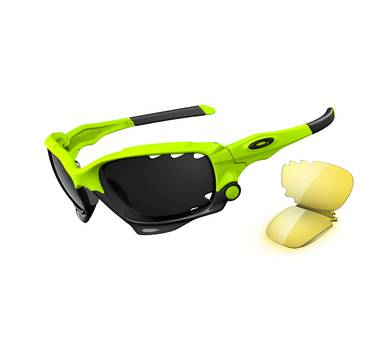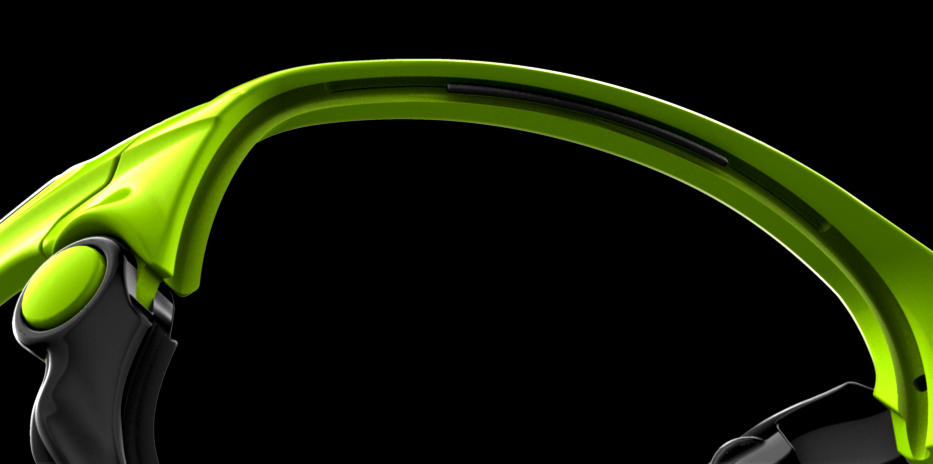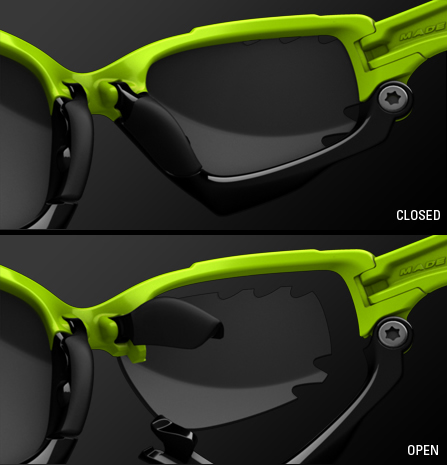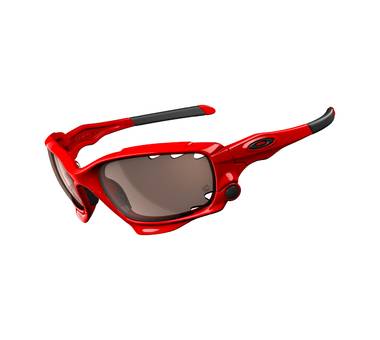Open Up and Say “Ah(mazing)”: Oakley JAWBONE

The Oakley RACINGJACKET, has been a perennial standard in the California optics company’s line-up for as long as I can remember. But the latest update, which puts a new name on the glasses to go a long with a host of new features, is a true show stopper. The Oakley JAWBONE features Oakley’s typically non pareil lenses, the incorporation of some newer features like the smudge and dust resistant HYDROPHOBIC coating seen first on the Radar series, and a brand new lens-changing system called SWITCHLOCK, which minimizes both the hassle of changing lenses as well as the distortion that comes from bending lenses to snap them into frames. The result is a new benchmark for what a pair of sport sunglasses should be.
Optics
As with all Oakley glasses, it is truly the optics that steal the show. I am consistently amazed not only by how good Oakley’s lenses are, but by how much better they are than those of their competition. As much as fancy features are what draw us to take notice, it’s the optics that really are at the core of eyewear. Oakley, who loves to trademark things, has actually trademarked their “trademark” optics under the umbrella of HDO, or “High Definition Optics.” As much as it seems a bit over the top with the phrase appearing about a thousand times on each pair of glass’s webpage, I realize how justified it is as soon as I put on a pair. The lenses are just that good. I almost feel as if they are prescription since, especially with some of the treated lenses, it actually seems clearer than looking with the naked eye.
The test pair that I received was fitted with a vented set of photochromic lenses with Transitions® technology. The photochromic lenses are light sensitive, and adjust relatively quickly to changes in ambient light. XTerra racers (or those who race on heavily forested courses as you often find in New England) will really appreciate these lenses for the responsiveness to changing light. In my own riding, it was just nice to have lenses that worked equally well in overcast conditions as when the sun came out. They are relatively bright lenses, with an average of 50% light transmission, but even on very sunny days, I never found myself wishing I had darker lenses in.

I’d also gotten a chance earlier to use a pair of Oakley’s polarized lenses, which are not vented, but which nevertheless did not suffer from any fogging, at least during my usage. The polarized lenses are the only set for the Jawbones which are not vented, perhaps belying a preference among end users in sports where polarized lenses are essential but where the venting is not necessary, such as watersports. Personally, I really enjoy polarized lenses, especially for morning races with a lot of moisture in the air. I find the polarizing makes these conditions much clearer. Certainly for races like St. Croix or Kona, where a great deal of the ride is near the ocean, I would think cutting down on glare off the water would be an asset. Hopefully Oakley might consider adding some vented and polarized lenses to the lineup at some point in the future.
All of the lenses feature Oakley’s new HYDROPHOBIC technology. Technically, this is a trademark, but since hydrophobic is actually a word that pretty much means the same thing as what they are trademarking, I find this sort of odd. Anyway, I digress (as I am wont to do when writing these things). In any case, what this means is that if you sweat a lot or are not so accurate with your water bottle, you don’t have to worry about the lenses becoming totally useless over the course of a long race. On paper, this may not seem like a big deal, but in practice, it can be a huge asset, especially when oxygen deprivation and fatigue make navigating your bike challenging enough.

Fit
I won’t spend too much time talking about fit, since my head, ears, eyes, and nose are obviously not the same as anyone else’s. I found the glasses to be comfortable for long rides. They didn’t slip, due in part to Oakley’s grippy UNOBTANIUM stem sleeves, but even more due to a snug, but not too tight, fit all over. The larger frame size kept the glasses from ever interfering with my ability to see, even when in the aero position. Despite being a full-frame pair of glasses, they work like a frameless pair in terms of your ability to see out of them. They sit quite close to your face, and as such, all you see is lens, even out of your periphery. For folks who are having trouble with their glasses impeding their vision when they are down in the aerobars, these would be at the top of my “to try” list. The larger overall frame size does make these glasses seem a bit big, always one of my personal fashion criticisms of the old RACINGJACKETs, but with the available two-tone color schemes, the JAWBONE actually looks quite a bit smaller on that it actually is, at least if you chose to get a two-tone pair. The single color pairs look bigger, though not overwhelmingly so, and I never got the impression, either looking out from them or from looking at pictures that I was wearing the equivalent of a welding helmet. But if you’ve got a tiny face, probably best to try on a couple different color options to see for yourself. The presence of a single torx bolt on the lower pivot makes me think you can play "mix-n-match" if you are willing to shell out for multiple pairs, but I wasn't able to confirm this yet. Buying two pairs just for this purpose seems a bit excessive, and I'm hoping that Oakley puts these glasses into the same customization program they done for the Radars.

Lens Change
The real highlight of testing these glasses was playing with Oakley’s SWITCHLOCK technology. To change lenses, you simply flip up one of the nosepieces, and then the bottom half of the frame swings open, allowing you to easily swap lenses, without ever needing to touch anything more than the sides of the lenses. The whole process is extraordinarily easy, with the lenses easily sliding out of or dropping into the frames. Oakley says it has the added benefit of “floating” the lens in the frame (the top of the frame has a very thin rubber cushion to prevent the lens from bouncing or moving), which means there is no flex in the lens, which means that there is no distortion of any sort. The end result, according to Oakley, are their clearest and most precise optics to date. I imagine that this is the sort of 1% improvement that is pretty difficult to detect, especially when you are talking about 99% versus 100% clarity, but I certainly would say that these glasses are wonderfully clear. For me, the added bit of clarity is probably not something that would really sell me, but the ease of changing lenses certainly would. I’ve had my fair share of glasses where the frames or lenses or both that have cracked from repeated lens changes. I’ve found myself fumbling with to snap lenses in and out of systems that were much more difficult to use than they should have been, and which were made even more difficult by virtue of it being before a race when clouds had rolled in (or out), changing what I’d expected I’d need at the last minute. The SWITCHLOCK system is a no-brainer, though the one area for concern is the relatively high number of moving parts, though moving parts that are meant to move is always better, in my opinion, than moving parts that are not meant to move. Only time will tell how this system stands up to wear and tear. After a couple weeks of wear, I have no complaints, but when you pay this much for glasses, it’s what happens after a couple of years that matters. Oakley’s reputation is what I’d rely on here.
Weight
As an addendum, out having my curiosity piqued, I decided to throw the glasses on my little scale just to see what they weighed. I measured the Jawbones (with lenses) on at 28g. For reference, the lightest pair I've found is the Nike Odeon Swyft, which is a frameless design that tips the scale at a scant 18g. My previous racing glasses, the Spiuk Yara, also a frameless design, weigh 24g. For a pair of glasses of similar size, I chose the Rudy Project Ekynox, which I used my internal estimator to size up; these glasses weighed 36g. In an effort to isolate the differences, the Oakley lenses weighed 4g apiece, as compared with 6g for the Ekynox. So about half the total difference between glasses is in lens weight, and the other half is in the frame. I also picked out a pair of Spiuk Sonic glasses, which are also a full frame glass. These ones have 5g lenses, but the total weight is only 24g. I suspect that the metal torx screw in the Switchlock mechanism probably accounts for most of this additional weight in the frame, as the Sonic has no metal on it at all, save for the small hinge screw. Overall, the Jawbone seems quite light for a pair of full-frame glasses, and my little scale seemed to reinforce this perception. However, in almost all cases, most good sport sunglasses are light enough that you'll never notice them. To give you some perspective, I found a pair of iPod headphones to weigh 18g and a single house key to weight 9g. So in no case are any of these glasses going to weigh you down.
All in all, the JAWBONE is the nicest pair of sport sunglasses I’ve ever used. The fit, optics, and visibility in the aero position are all superb. And the ease of changing lenses puts a brilliant finishing touch on an already first-rate pair of glasses. For those of you who need – or most likely want – a new pair of glasses for this season, the JAWBONE would be at the top of my list.
For more information, visit Oakley.com/Jawbone.

